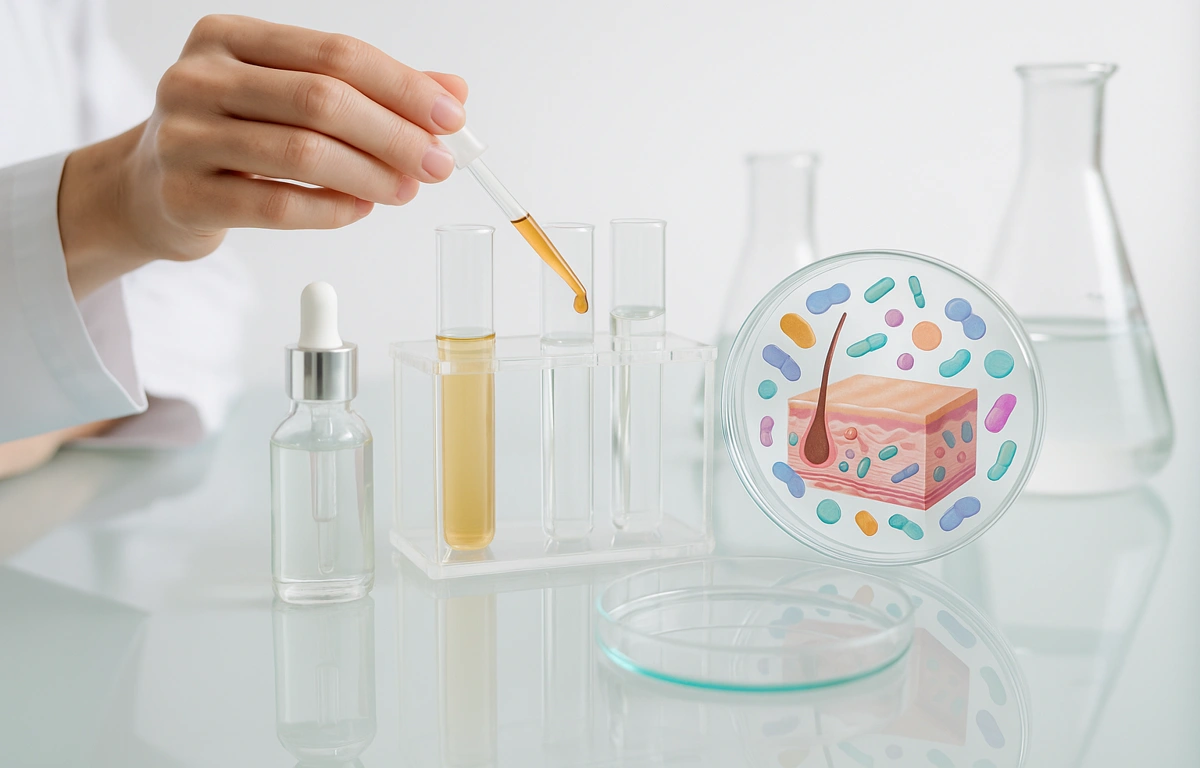Just a decade ago, even many physicians didn’t consider that the skin’s surface is home to a vast colony of microorganisms. Sterility was seen as the ideal and bacteria as enemies. Thanks to advances in genetic analysis (metagenomics), we now know: a large share of the cells that “live” with us are not human but bacterial. The skin microbiome is not a threat—it’s a fundamental prerequisite for skin health.
The Microbiome as an Ecosystem
The skin is the body’s largest organ and harbors over 1,000 bacterial species. Its composition depends on:
- Body area: lipid-loving Cutibacterium acnes dominate the forehead and nose; Corynebacterium thrive in the underarms; Staphylococcus epidermidis is common on dry hand areas.
- Age: children’s skin is more diverse; in adolescence, C. acnes often dominates; in mature skin the balance shifts again.
- Sex, hormones, climate, and lifestyle further shape the community.
Think of it as a small “city,” where each species has a job: some police pathogens, some maintain acidity, others synthesize beneficial compounds. Korean labs were early pioneers here. Manyo Factory offers lines featuring Bifida ferment lysate that combine fermentation with probiotic skin care. These aren’t antiseptics; they help skin coexist in balance with its microscopic world. Explore them on the official Manyo website.
How the Microbiome Shapes Skin
1. Trains the Immune System
Resident microbes constantly “coach” immune cells, helping skin respond only to real threats. When the microbiome is depleted, minor triggers can spark inflammation.
2. Produces Helpful Molecules
Some bacteria make bacteriocins—natural antibiotics that suppress pathogens. Others produce fatty acids that help maintain an acidic pH.
3. Buffers Oxidative Stress
The microbiome helps neutralize free radicals generated by UV exposure and pollution.
4. Influences Pigmentation and Barrier Function
Research suggests a healthy microbiome can modulate melanin pathways and the quality of intercellular “cement” (ceramides).
Gut–Skin Axis: The Invisible Link
You can’t discuss the skin microbiome in isolation from the gut. They’re connected along the gut–skin axis.
- Gut dysbiosis (from antibiotics, stress, low-fiber diets) raises the risk of acne, rosacea, and atopic dermatitis.
- Nourishing nutrition—fiber, vegetables, fermented foods—also “feeds” the skin’s microbiome via systemic pathways.
Myths vs. Facts
- Myth: Breakouts come from “dirty” skin.
Fact: They often stem from microbial imbalance when normally harmless species turn aggressive. - Myth: Antiseptics are the best protection.
Fact: Overusing alcohols and antibacterials wipes out “good” bacteria along with the bad. - Myth: Probiotics are only for the gut.
Fact: Topical probiotics can calm inflammation and help restore the barrier.
How to Support a Healthy Microbiome
The microbiome is exquisitely sensitive. Harsh routines can disrupt it—but daily, thoughtful care can restore balance.
1. Use Gentle Cleansers
- Why: Beneficial microbes live in the outer epidermis and within the sebum film. Harsh surfactants, alkaline soaps, and alcohol strip this ecosystem.
- Choose: pH-balanced (4.5–5.5) gels/foams without SLS or high alcohol. Amino-acid surfactants, coco-derived agents, and mild glucosides work well.
- Practice: Morning often needs only water or a very mild foam; evening can be a gentle double cleanse (oil cleanser + mild gel).
2. Add Prebiotics, Probiotics, and Postbiotics
- Prebiotics (e.g., inulin, alpha-glucan oligosaccharide) feed beneficial microbes.
- Probiotics (live cultures or lysates, often Lactobacillus or Bifidobacterium) help recolonize and rebalance.
- Postbiotics (fermented extracts, peptides, microbial metabolites) act as signals, reduce inflammation, and stimulate ceramide production.
- Together: prebiotics nourish, probiotics seed, postbiotics signal—synergy matters.
3. Strengthen the Barrier
- Ceramides rebuild tight, resilient stratum corneum.
- Fatty acids (omega-3, omega-6) moisturize and temper inflammation.
- Niacinamide boosts ceramide synthesis, reduces reactivity and redness.
- Glycerin, squalane, hyaluronic acid create a hospitable environment for skin flora.
4. Tame Aggressive Routines—Schedule “Rest Days”
- Chemical peels, retinoids, and frequent scrubs are effective—but overuse can “burn” the ecosystem.
- What to do: Introduce actives gradually and pair them with barrier care.
- Rest days: 1–2× weekly routines with just the basics: gentle cleanse, hydration, prebiotics/ceramides.
5. Support from Within: Diet, Stress, Hydration
- Diet: fiber, fermented foods (yogurt, kimchi, fermented veggies), and healthy fats support gut and skin microbiota.
- Stress: cortisol shifts pH and stokes inflammation—sleep, relaxation, and movement restore balance.
- Water: systemic hydration benefits both gut and skin flora.
Microbiome-Friendly Skincare: What to Look For
This is more than a marketing term; it’s a scientific direction evolving along three lines:
1) Formulation: Microbiome-Active Ingredients
- Prebiotics: inulin, fructooligosaccharides, maltodextrin.
- Probiotics: Lactobacillus filtrates, Bifida ferment lysate (widely used in Korean skincare).
- Postbiotics: fermented plant extracts, bacterial lysates.
- Adjuncts: niacinamide, zinc, panthenol to create favorable conditions.
2) Format
- Toners & mists with ferments/probiotic complexes for daily maintenance.
- Serums to rebalance after stress or procedures.
- Creams/emulsions with prebiotics and ceramides for daily barrier care.
- Masks (sheet or overnight) for rapid reset after travel, peels, or intense sun.
- Gentle cleansers with probiotic complexes that cleanse and “feed.”
3) Indications
- Sensitive/reactive skin—less redness and fewer flare-ups.
- Anti-acne—curbing excessive C. acnes and normalizing the milieu.
- Anti-age—supporting collagen quality and barrier integrity reduces visible aging.
- Post-procedure—re-seeding flora to speed barrier recovery after peels, lasers, microneedling.
Supporting the microbiome is a long-game strategy. It’s not a passing fad but a paradigm shift—from sterility to harmony. Skincare that preserves this balance is becoming the new standard of professional care.

